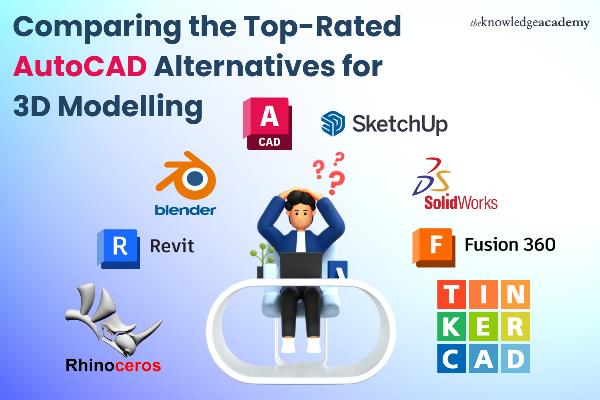Comparing the Top-Rated AutoCAD Alternatives for 3D Modelling

When it comes to 3D modelling software, AutoCAD has long been a cornerstone. Yet, for many designers and engineers, the quest for more versatile or cost-effective solutions is ongoing. This exploration for AutoCAD Alternatives is not just about finding cheaper options; it's about discovering tools that can streamline workflows, enhance functionality, or better match specific project requirements.
In this blog, we'll dive into some of the top-rated alternatives to AutoCAD that excel in 3D modelling. We'll compare their features, usability, and cost to help you determine which might be the best fit for your professional or personal projects.
Table of Contents
- SketchUp: User-Friendly Interface for Beginners
- Blender: Powerful and Free
- SolidWorks: Precision Engineering
- Revit: BIM Specialist
- Fusion 360: Integrated Cloud Platform
- TinkerCAD: Ideal for Educators and Hobbyists
- Rhino: Advanced Surface Modelling
- Conclusion
SketchUp: User-Friendly Interface for Beginners
SketchUp is renowned for its user-friendly interface, making it a great starting point for beginners in 3D modelling. Unlike AutoCAD, SketchUp allows rapid modelling with an intuitive toolset that can be learned quickly.
- Ease of Use: SketchUp's straightforward toolbar and instructor panel provide real-time guidance, making it accessible for newcomers.
- Features: Includes a 3D warehouse, which is one of the largest libraries of free 3D models.
However, while SketchUp is excellent for basic models, it may lack the technical depth required for more complex engineering projects.
Blender: Powerful and Free
Blender is a powerful open-source tool that stands out among free AutoCAD alternatives. It's well-suited for artists and designers who need robust modelling, rendering, and animation capabilities.
- Cost-Effective: Completely free, offering extensive features without the premium price tag.
- Capabilities: Supports everything from modelling and texturing to animation and video editing, making it a versatile tool.
Blender's complexity, however, can be daunting for beginners, requiring a steeper learning curve to fully leverage its capabilities.
SolidWorks: Precision Engineering
SolidWorks is a solid choice for professionals who need precise and detailed engineering capabilities. It is particularly valued in industries like manufacturing and automotive for its advanced features.
- Specialisation: Focuses on precision and the ability to handle complex assemblies.
- Integration: Excellent for integrating with other engineering applications, facilitating a seamless design-to-manufacture process.
While SolidWorks offers deep functionalities, it is significantly more expensive than some other alternatives and might be overkill for simpler projects.
Revit: BIM Specialist
Revit is another Autodesk product but is specialised for Building Information Modelling (BIM). This makes it ideal for architects and builders who need to focus on construction and utilities rather than purely artistic 3D modelling.
- BIM Features: Offers tools specifically for architectural design, MEP engineering, structural engineering, and construction.
- Collaboration: Allows multiple users to work on the same project file, enhancing teamwork.
Revit is best for those in the construction industry and is less suited for general 3D modelling.
Fusion 360: Integrated Cloud Platform
Fusion 360 blends CAD, CAM, and CAE in a single platform, offering a cloud-based solution for more streamlined project management.
- Cloud-Based: Allows users to access and share their work from anywhere, on any device.
- Versatility: Combines industrial and mechanical design with simulation capabilities.
Ideal for collaborative projects and professionals needing a comprehensive toolset, Fusion 360 might, however, require a subscription that could be costly over time.
TinkerCAD: Ideal for Educators and Hobbyists
TinkerCAD is another excellent alternative, especially appealing to educators and hobbyists. It’s a web-based application that makes it easy to start 3D modelling with no software installation required.
- User-Friendly: Designed with beginners in mind, TinkerCAD offers a straightforward interface and a suite of educational tools.
- Applications: Perfect for classroom settings or personal projects, such as creating models for 3D printing.
TinkerCAD's simplicity makes it less suitable for professional-grade designs but excellent for introducing the fundamentals of 3D modelling.
Rhino: Advanced Surface Modelling
Rhino, or Rhinoceros, is known for its unparalleled capabilities in surface modelling. It's ideal for designers who need to create complex and detailed models.
- Complex Modelling: Provides tools for precision modelling of intricate shapes and surfaces.
- Flexibility: Compatible with numerous plugins, enhancing its functionality to suit specific project needs.
Rhino is a bit more niche in its application, excelling in scenarios where complex forms need to be articulated with high accuracy, such as in industrial design or architecture.
Conclusion
Choosing the right 3D modelling software depends heavily on your specific needs and the complexity of the projects you intend to undertake. Each software mentioned in this blog offers unique strengths. By considering your requirements and budget, you can select an alternative to AutoCAD that exceeds your expectations and allows you to create with precision and efficiency.
If you want to learn about AutoCAD, The Knowledge Academy offers comprehensive courses that can help you master this tool and enhance your skills.
Note: IndiBlogHub features both user-submitted and editorial content. We do not verify third-party contributions. Read our Disclaimer and Privacy Policyfor details.







